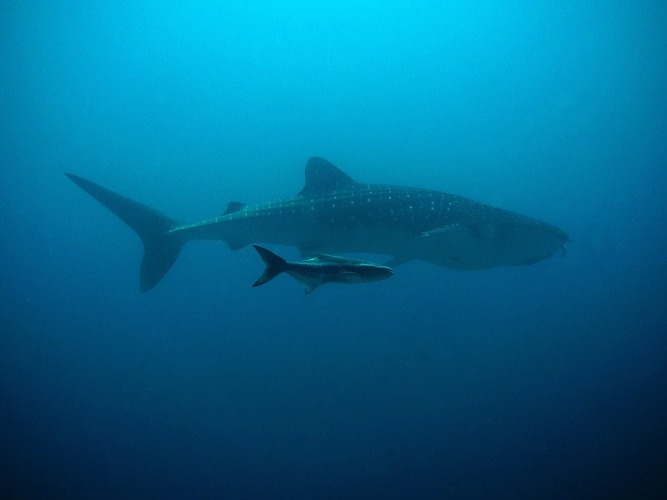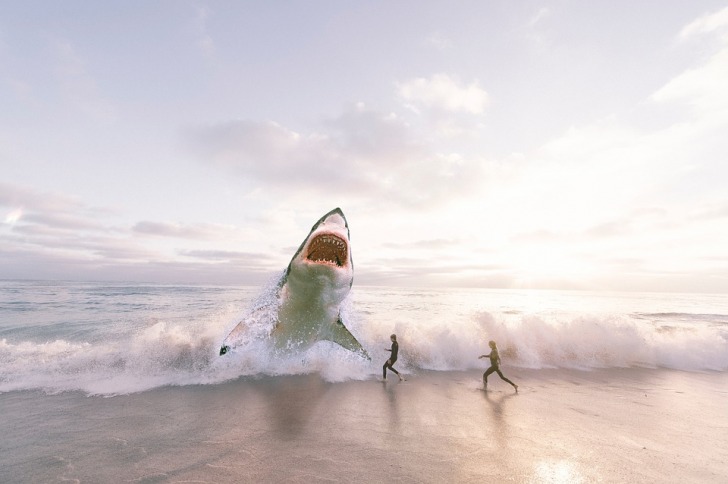Many people became fearful of large bodies of water after seeing the movie Jaws and the havoc it caused in a New England town.
But some of those fears are warranted.
According to Freedomwatersports.com, the Gulf of Mexico is home to numerous fish, including sharks.
When you get into the water, remember you are sharing it with sharks and other marine life that may not want you entering their home and sanctuary.
Contents
So…Are there Sharks in the Gulf of Mexico?
Yes, there are sharks in the Gulf of Mexico!
Many species make their home in the warm waterway.
As recently as September 2021, CNN reported that a 64-year-old man who was in his fishing vessel untangling rope from his propeller fell into the water.
The man had part of his leg bitten off by the shark and had to have emergency assistance from the Coast Guard and was taken to a New Orleans hospital in critical condition.
Because the shark swam away after the attack, authorities were unable to determine the size of the breed of the shark.
According to Trackingsharks.com, in 2021 there were 42 shark attacks across the U.S.
Of those 26 occurred in Florida, three in California, and seven in Hawaii.
One proved to be fatal.

There are numerous types of sharks found in the Gulf of Mexico.
Many people go out fishing for some varieties because they can be delicious to eat.
Others find them when they are in the water having fun when a shark comes in closer to shore.
Here are some of the varieties of sharks commonly found in the Gulf of Mexico:
Bull Shark
Many fish for Bull sharks.
However, they must be 54-inches long before they can be caught, if they are not that long they must be released.
These sea creatures can grow up to 11 feet long and are rare because they can live in salt water and fresh water.
They are considered quite dangerous as they have the third-highest number of attacks on women, after all, they can live in just about any body of water.
Great Hammerhead Shark
The Great Hammerhead shark is a protected species as of 2014.
These sharks can grow to over 13 feet long.
The Great Hammerheads are seen in the Gulf of Mexico, but closer to shore in the areas around Panama City, the Scalloped Hammerhead is more commonly seen.
The Scalloped Hammerhead has a smaller head than is seen in the Hammerhead Shark.
According to National Geographic, Hammerhead and Scalloped Hammerheads are hunters of prey, like squids and other fish, but they will only attack humans as a defense mechanism if they are provided by humans.
Sand Tiger Shark
According to Wikipedia.org, Sand Tiger Sharks are scary-looking creatures.
They have pointed heads and a large, bulky body.
They are grey with red spots and can grow up to nearly 11-feet long.
Fortunately, they are rather slow swimmers, and to date, they are not known to have attacked any humans.
They are happy hunting in schools and mainly live on fish, squid, skates, and even other sharks.
Shortfin Mako Shark
The Shortfin Mako Shark has numerous aliases.
They are also called Blue Pointer or Bonito Shark.
They can reach a length of 13-feet when mature.
They are considered an endangered species, so they cannot be fished for sport.
The Shortfin Mako sharks are powerful and fast, they can reach top speeds of 60-miles an hour, about as fast as you drive your car on the highway.
They are responsible for several shark attacks on humans.
When they are eying their prey, they swim in figure-eight patterns with mouths open.
They also swim towards the bottom of the water so they can look up to find their next meal before they are spotted.
Blacktip Shark
In most cases, Blacktip sharks prefer to avoid humans, but if you go too close to them, they have been known to bite people they perceive as invading their habitat.
According to AmericanOceans.org, these sharks are considered rather safe to swim with.
Many divers find them close to coral reefs and swim with them with no problems.
It seems that issues arrive when the sharks are migrating, which take them through shallow waters.
So, they may come closer to beaches than other sharks.
Because the water is often clouding close to shore, instances, where they have bitten a human, have these murky waters and think a human appendage looks like a fish.
They can easily be spotted with their top fin above the water; it is grey with a black tip.
Lemon Shark
The Lemon shark is easy to spot as it has a yellow skin tone that helps it hide in sandy areas away from predators.
They represent very small threats to humans and have only been involved in 10 unprovoked takes on humans.
These all occurred in Florida and the Caribbean.
According to Oceana.org, rather than mess with humans, the lemon shark enjoys hunting for bony fish and stingrays in the sandy bottom of the waterway, though some have been spotted in coastal waters and entering freshwater.
They often travel in groups of up to 20 and feed together as the sun comes up and goes down.
You cannot fish for Lemon sharks as they are on the protected species list.

Is it Safe to Swim in the Gulf of Mexico?
The Gulf of Mexico is home to beautiful beaches, resort towns, and stunning sunsets.
However, you need to take precautions before you enter the water.
It is the ninth-largest body of water in the world and home to sharks and other marine life that you need to be careful of.
Tripshock, states that the Gulf of Mexico has over 1,443 species of finfish, 51 types of sharks, 42 ray/skate fish, and many others like jellyfish.
Here are some of the sea creatures to look out for:
Stingrays
There are numerous species of stingrays in the Gulf of Mexico.
They have a stinger on their long tail, they nearly never hurt humans unless they feel threatened.
In most cases, they avoid people and are peaceful.
They can easily be camouflaged in the sand, so most cases of being attacked have occurred when they were inadvertently stepped up.
The best thing to do is to shuffle your feet when walking in shallow waters, this will frighten them, and they will move on to a new location
Hardhead Catfish
While they will not attack you, these catfish can be caught while fishing.
If you catch one of them, be careful of the spines that protrude from their fins.
They can sting you delivering a painful poison, that can cause numbness and swelling.
It usually subsides in a few hours.
Experts warn that you should not attempt to suck out the poison delivered from the catfish spines as they can cause other problems when their poison gets into the throat and sinuses.
Barracuda
Conquer the Water states that Barracudas have a bad reputation for being a mean and ferocious killers, but they may be getting a bad rap.
They would much prefer to swim around reefs and scavenge for food than attack a human.
They are attracted to sunlight, so those planning to go diving need to take off anything that could glimmer as with their poor eyesight, they may think it is a fish.
It appears there are only about 25 documented Barracuda attacks in the last Century, so it is extremely rare.
In most cases, it appears that when a barracuda strikes it is because they feel threatened, or they mistake a swimmer for prey
Jellyfish
Jellyfish are one of the most commonly found marine animals that cause harm to humans.
Often Gulf beaches will have purple flags on the beach to signify that there have been signs of Jellyfish.
One encounter with a Jellyfish can lead a happy vacationer to a trip to the emergency ward.
There are hundreds of different types of Jellyfish in the Gulf of Mexico, including the most popular varieties:
- Moon Jellyfish
- Portuguese Man-Of-War
- Sea Nettle Jellyfish
- Blue Button Jellyfish
- Mushroom Cap
Of these, the Portuguese Man-of-War is considered one of the most dangerous.
A sting from a Jellyfish can cause immediate pain, those that have an allergic reaction to their sting may get very ill and even die on rare occasions.

Interesting Shark Facts in the Gulf of Mexico
According to PEW Trusts, there are a wide variety of sharks in the Gulf of Mexico, many will be happy swimming alongside you, others do not want you anywhere near them and will be more aggressive.
Here are some facts about sharks in the Gulf of Mexico:
- Sharks have been on earth for 400 million years and have continued to evolve.
- There are 350 species of sharks worldwide; at least 24 of them swim in the Gulf of Mexico.
- They have sensory organs on their snout to help them find their prey.
- They also have strong sensory organs that help them find injured marine life.
- Sharks have low reproductive rates and can take up to 18 years to reach maturity and mate.
According to Oceana.org, most sharks prefer saltwater and if they end up in a lake, it is usually connected by waterways to the ocean.
Sharks are large so they need large, deep areas of water to live.
Since most sharks can only live in saltwater that is dark, freshwater is not their ideal habitat.
The one exception to this is the Bull shark, which can live in freshwater due to its ability to osmoregulate.
This means their bodies can adapt to different salt levels.
They have traveled upstream in warm waters and have even been found in the Mississippi River and North Carolina’s Neuse River.
It is still unlikely that you will encounter a shark in a lake, stream, or river.
Three Safety Tips for Swiming in Shark-infested Water
National Geographic offers these safety tips when sharing the water with sharks:
- Most sharks will not bother humans: Most of those that have been attacked have recovered. Sharks are most likely to attack if they feel threatened. The best thing to do if you spot a shark is to move quickly out of its way, they have very poor eyesight and rely on their other senses.
- Stay away from fishermen: Fishermen use fish for bait, which causes blood in the water. Sharks are attracted to the smell of blood and will go to that area to feast on what they perceive to be dead fish and other prey.
- Swim with others: Most shark attacks occur when someone is swimming alone. It is better to swim in groups that will care off sharks.
Summary
No matter where you are swimming, you should be aware of your surroundings and check for flags that can denote rough waters, jellyfish, and shark sightings.
You should also swim in groups for extra safety.
If you are not sure if the water is safe, ask hotel management, travel experts, or local travel information specialists to see if the water is free of sharks and other predators.
Sources
- https://www.cnn.com/2021/09/03/us/shark-attack-in-gulf-of-mexico/index.html
- https://freedomwatersports.com/sharks-in-the-gulf-of-mexico/
- https://www.nationalgeographic.com/animals/fish/facts/hammerhead-sharks
- https://en.wikipedia.org/wiki/Sand_tiger_shark
- https://allthatsinteresting.com/mako-shark
- https://www.americanoceans.org/facts/are-blacktip-sharks-dangerous/
- https://conquerthewater.com/are-barracuda-dangerous-to-snorkelers/
- https://www.pewtrusts.org/en/research-and-analysis/fact-sheets/2012/03/12/sharks-in-the-gulf-of-mexico-the-facts
Frequently Asked Questions
Is it safe to swim in the Gulf of Mexico?
In most cases yes, if you are careful and stay within the preset boundaries and do not go out to restricted areas where predators have been spotted.
Why do they suggest taking off all jewelry before diving?
Sharks and other predators do not see well.
Anything shiny can look like prey.
How can I look for stingrays?
Stingrays are found in sandy areas and are often found migrating toward the sandy beach.
When you enter the water, slide your feet, if there is a stingray, they will notice the motion and move on.












Yes, there are sharks in the Gulf of Mexico and they can pose a threat to swimmers and fishermen.